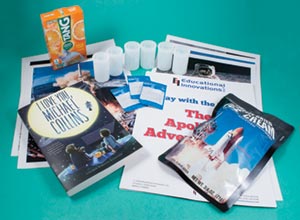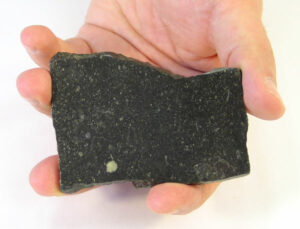 by Ted Beyer
by Ted Beyer
Ever since I was a kid, I have been fascinated with space. I would look up at the stars, and I just knew that other people were up there somewhere, looking back at our little point of light, and thinking the same kind of thoughts. On the day I turned seven, Neil and Buzz landed on the moon and I was sure that—somehow—when I grew up, I would get there, too.
Incidentally, that’s me in the red on the right in the picture below. And on the left? Well, that’s Buzz Aldrin!
Just a quick note:
 Here we are now, nearly 50 years after that day I was eating birthday cake as we heard “Tranquility base here, the Eagle has landed.”
Here we are now, nearly 50 years after that day I was eating birthday cake as we heard “Tranquility base here, the Eagle has landed.”
To celebrate that historic landing, Educational Innovations has created an exclusive kit. If you teach science at an elementary or middle school level, I strongly encourage you to check out the Apollo 11 Adventure Kit. It’s full of lots of fun and interesting lesson plans and hands-on activities—along with an autographed copy of the award-winning children’s book, I Love You Michael Collins. Be sure to check out their selection of astronomy science tools too!
We haven’t found anybody yet who isn’t enchanted by the pen pal letters that 10-year-old Mamie decides to write to Michael Collins, the Apollo 11 astronaut who stayed with the ship. Plus, who can resist Tang?!
Back to Meteorites!
Dreams can be dashed by reality and time, but the desire can still live on. I became a collector of all things space…and NASA. Soon I found that collecting meteorites was not only possible, but also fascinating. Here are objects that spent millions of years wandering through space, only to endure a fiery entry through our atmosphere to end up, astonishingly, in my hands.
The more I researched these space travelers, the more I became awed by their vast variety and appearance. When most people think of meteorites, they tend to think of the Nickel – Iron type (or at least I did). Heavy metal, often pockmarked, objects, dull black or grey. Wasn’t I surprised to discover that the Irons make up only about 6% of FOUND meteorites, by number, and 11.3% by weight. In collections, they make up 27.7%. The Chondrites (one form of the stony meteorites) make up 75% by weight and 85% by number found!
In spite of this, my small collection still only has one stony. My one and only stony (so far); pictured to the left, is a slice of the Ghubra meteorite, which was found in Oman in 1954.
See the white spot on the bottom left side of the specimen? I am assured by experts that the spot, called a chondrule, is older than the planet Earth by as much as 500 million years!
 The pride and joy of my collection is one of the rarest types of Irons. A type of Stony – Iron meteorite called a pallasite.
The pride and joy of my collection is one of the rarest types of Irons. A type of Stony – Iron meteorite called a pallasite.
Pallasites are made up of Iron – Nickel, but have crystallized almost gem-like grains of Olivine, a silicate that varies in color from a brownish yellow to an olive green, embedded in the iron-nickel matrix which can rage up to 1 cm or more in size.
These are easily the most beautiful of all meteorite types. As I said, they are also quite rare – making up less than 1% of specimens found. As you might imagine, they fetch a fairly high price (I saved many pennies to get mine).
 The first meteorite I acquired was one of the most common and best known. The Campo del Cielo (Field of Heaven) meteorite find is truly vast. Known by natives for uncounted years, it was first found and named by Spanish explorers in 1576 in the Chaco province of northern Argentina. The two largest known masses are 37 and 18 tons and are considered national treasures. Tens of thousands of smaller masses ranging from just few grams to hundreds of kilos have been found, and are often found for sale to collectors.
The first meteorite I acquired was one of the most common and best known. The Campo del Cielo (Field of Heaven) meteorite find is truly vast. Known by natives for uncounted years, it was first found and named by Spanish explorers in 1576 in the Chaco province of northern Argentina. The two largest known masses are 37 and 18 tons and are considered national treasures. Tens of thousands of smaller masses ranging from just few grams to hundreds of kilos have been found, and are often found for sale to collectors.
I have been lucky enough to visit the Tucson Gem and Mineral show several times. This is the largest mineral show on the planet, and is held every year in February. These visits have enabled me to see many meteorites (and even buy a few!) and meet several of world’s leading collectors and dealers.
On one visit, we were able to acquire some fairly large (300g or so) Campo del Cielos that were in somewhat distressed condition. Since they were iron and hadn’t been properly cared for, they were somewhat rusty. I spent a fair amount of time figuring out how to stabilize them, and more time actually doing the work to remove most of the rust. When I was done, they were in pretty good shape. More could be done, but I thought it might be interesting for our customers to get in on the activity as well.
While all of those samples are now long gone to happy customers (I wish we had more to share), we do have a nice selection of smaller meteorite samples of three falls—the Sikhote-Alin from Russia, the Nantan from China, and of course the Campo del Cielo from Argentina.
I think that people with even a slight interest in space and the unknown will be fascinated by the simple act of holding a meteorite in their hand. An object that has spent the vast majority of its life wandering between the planets—going places that most of us can only dream of going—holds its own magic.



Hi Ted:
Really neat blog. Thanks. I could get ‘hooked’ collecting yet another variety of interesting stuff.
Marty
Dear Ted Beyer,
I greatly enjoyed your article. I found it to be highly informative.
I have a Campo del Cielo that is just quietly rusting away.
Can you please tell us how to cleaned and stabilize one of these rust buckets, or tell us of a link that covers this subject?
Thank you in advance for your kind assistance in this matter.
Sincerely,
Ken
Hi Ken —
This is what I did after spending a good bit of time asking around. Note that there are LOTS of different opinions on what do do, and lots more than you can do, but here goes:
First I brushed off the loose rust with a brass bristle brush. Then a 30 second soak in CLR brand cleaner (look in the bathroom cleaning section of your supermarket). More work with the brass brush and perhaps another dunk in the CLR if the rust was still really bad. Then a rinse in a baking soda and water solution to neutralize the CLR, followed by a rinse with clean water.
I then baked them at 250° for 3+ hours to drive out the majority of trapped moisture, and then dunked them into pure mineral oil while still hot. You will likely note some dark brown spots on the surface. These are more deeply ingrained rust spots, which will require additional cleaning to remove. You can leave your meteorite in that condition, but you will need to maintain it in order to prevent the rust from worsening.
Were you to buy one of our formerly rusty Campos, this is as far as it was taken…
Of course you can (And should) do lots more —
To preserve your meteorite, you will want to take one or more of these steps:
Depending on your local humidity, you will want to re-bake your meteorite in a 200° – 250° degree oven from time to time. This will need to be done about once a year, or as often as every month in humid areas. Allow 1 hour+ per pound of meteorite being treated, but at least one hour in a pre-heated oven in any event. This will drive out most of the residual moisture that the sample may harbor. You may want to put the sample on a non-metallic oven safe dish to prevent any interaction with the oven rack. BE CAREFUL when removing the sample from the oven – it will stay hot for an extended period.
If you live in very humid areas, or if rust spots appear frequently, you may need to take more aggressive steps to dry your sample. Remember, water is your enemy – even the water vapor in the air. There are many differing opinions of how to accomplish this and you can search the Internet and find your favorite.
These include mineral oil or light grease coatings, sealed display cases with replaceable desiccant canisters, various products designed to preserve and protect firearms, and other metal protectors.
If you want to work on removing the remaining rust, you need to know several things: As the meteorite was exposed to extreme heat as it entered the atmosphere and due to exposure to the elements after it landed, it developed a patina, or crust on the outside which is often black or brownish in color. In the case of this sample, the crust has been broken due to the rusting, which occurred subsequent to its discovery. This leaves you in the position of deciding whether to try and save what is left, or to remove the crust all the way down to the bare metal.
As with most meteorite preservation discussions, there are many differing schools of thought. Here are some suggestions.
Note that when you are satisfied with your cleaning job, you will want to follow the instructions on drying and preserving your sample given above.
Using a stiff nylon or brass bristle brush, remove as much of the visible rust scale as possible. Resist the temptation to use a rotary tool (a drill or grinder with a wire wheel for example) except as a very last resort, and avoid a steel tool at all costs. These tend to change the character of the sample and leave tool marks. A brass bristle wheel, used sparingly and with care (wear eye protection and heavy gloves!) can be useful in extreme situations. Doing the work by hand will require some elbow grease, but will usually result in the best overall final product.
Blowing off the loose material with compressed air, or a quick rinse with distilled water, will enable you to see how far along you are in the process.
If you are have some really stubborn spots, or if you are trying to get the sample down to the bare metal, you might consider using more CLR® Brand rust remover (available with other cleaning supplies in most grocery stores). A soak of a minute or so, followed by more work with your brush, and a distilled water rinse will often remove stubborn rust spots. This process can be repeated several times as needed. Once you are satisfied, be sure to neutralize the cleaner by rinsing the meteorite in a baking soda solution, followed by a thorough rise in distilled water.
Of course, we have re-introduced water to our sample – and as always water is the enemy. Remember – if at all possible avoid using anything containing water on your meteorite. If you must use water to help in removing another material used in your cleaning process use only distilled water (available at grocery stores) thus avoiding the chlorine and the various salts and minerals dissolved in tap water.
Drying the sample is again a must. You can simply bake the sample again, or if you want to go one step further, use chemical assistance. A long (overnight) soak in anhydrous alcohol (rather hard to get) is an option. You could also make use of 99% alcohol (also tricky to find but sometimes available at larger pharmacies), 95% Ethel alcohol (often available at hardware stores or even 91% will do in a pinch!) or Automatic Transmission Fluid (ATF) will help to remove residual moisture. As an added benefit the ATF will provide a nice oil coating to help prevent rust. If you use the ATF method, just rub off the excess when you remove the sample from the bath.
After the soak, you will, once again, want to bake your meteorite in a 200° – 250° degree oven (see above).
You will want to protect your meteorite from re-oxidizing. Resist the temptation to coat it with a clear coating of plastic or similar materials (silicon, pourable Lucite, etc.). Invariably, some moisture will be trapped under the coating, and rust will form under the coating. Several good protectors are pure mineral oil, WD-40® (loved by some collectors, hated by others), and the aforementioned firearms/metal protectors.
For small spots of rust, CLR® brand cleaner can be used effectively in small quantities by applying it to the rusted area with a Q-tip and gently rubbing it.
Hi Ted I have a metorite ring that I wear every day I have herd of baking the ring in wd40 at 200 for 2 hours to prevent the ring from rusting. I have very acidic hands and it rusts fairly quickly. Luckily I’m a jeweler and can re etch it and clean it whenever I want. I would like to figure something out so I don’t have to clean it multiple times a week.
This is really a tough one. As you already know, wearing an every-day ring causes you all sorts of problems — your hands are constantly exposed to moisture (and in fact are a CAUSE of moisture, and salt for that matter — ie: sweat).
All that being said, without resorting to a sealant (which, since you read the blog, you already know comes with it’s own set of problems) the best technique I have heard of is cover the piece with a material called RIG Universal Gun Grease (available from Brownells.com), and baking that in for a few hours, and then repeating that process (perhaps several times). I belive that will give better results than the WD-40 bake in you mentioned, but I can offer no promises — only guesses. Give it a try and let me know how it works for you.
I should mention one other possibility — Some meteorites (Nantans are a good example) have a tendency to rust from the inside out no matter what you do to them. They have micro fissures and, for want of a better term, “pores” that retain water like crazy – often from centuries of being buried in a wet, boggy area. They don’t rust under ground as they are starved of oxygen until they are dug up. This type is often referred to by collectors, somewhat tongue in cheek, as a “temporary meteorite” since there is not a lot that can be done to save them in the long term. Not knowing what your ring is made out of, I can not say if yours is one of them, but I thought I would throw that possibility out there.
Ted